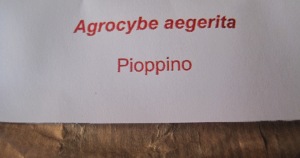Cultivating edible mushrooms at home may not be as easy as growing vegetables and fruits in our balcony. I had some success in germinating mediterranean tree seedlings at home, namely carob tree (Ceratonia siliqua), umbrella pine (Pinus pinea) and cork oak (Quercus suber). But this will be my first attempt to grow mushrooms.
It all started when I met Marta and Rui from Quadrante Natural. Their company organizes workshops dedicated to mushrooms production and sells the inoculum and materials necessary for it. My first reaction when I saw the inoculum was: This will be a great experiment to do with my nephew.
 O cultivo de cogumelos comestíveis em casa não deve ser tão fácil como manter uma horta na varanda. Eu tenho tido algum sucesso em germinar plantas mediterrâneas em casa, nomeadamente alfarrobeira (Ceratonia siliqua), pinheiro manso (Pinus pinea) e sobreiro (Quercus suber). Mas esta será a primeira vez que vou tentar cultivar cogumelos.
O cultivo de cogumelos comestíveis em casa não deve ser tão fácil como manter uma horta na varanda. Eu tenho tido algum sucesso em germinar plantas mediterrâneas em casa, nomeadamente alfarrobeira (Ceratonia siliqua), pinheiro manso (Pinus pinea) e sobreiro (Quercus suber). Mas esta será a primeira vez que vou tentar cultivar cogumelos.
Esta aventura começou quando eu conheci a Marta e o Rui da Quadrante Natural. Esta empresa organiza cursos de um dia sobre produção de cogumelos e vende o inóculo e o material necessários para essa tarefa. A minha primeira reação quando vi o inoculo foi: Isto vai ser uma grande experiência para montar com o meu sobrinho.

The cultivation process has similar stages for every mushroom species, but differs in the details. Basically, we have a substrate (preferably sterilized) where the mycelium will grow for two weeks in moist conditions. Then we change the conditions to allow fruitification, which means the formation of the mushroom.
For the time been, I have only decided the kind of substrate that we will use. Since one of Agrocybe aegerita favorite substrate is Acacia wood, we will test Acacia wood chips and branches as substrates.
 O processo de produção tem fases semelhantes para todos os cogumelos, mas difere nos detalhes. Basicamente, temos um substrato (de preferência estéril) no qual o micélio vai crescer durante duas semanas em condições húmidas. De seguida, alteramos as condições para favorecer a frutificação, ou seja a formação dos cogumelos.
O processo de produção tem fases semelhantes para todos os cogumelos, mas difere nos detalhes. Basicamente, temos um substrato (de preferência estéril) no qual o micélio vai crescer durante duas semanas em condições húmidas. De seguida, alteramos as condições para favorecer a frutificação, ou seja a formação dos cogumelos.
De momento, eu só decidi qual o substrato que vamos utilizar. Como um dos substratos favoritos do Pioppino é a madeira de Acacia, nós vamos testar aparas de madeira e ramos de acácia como substratos.


